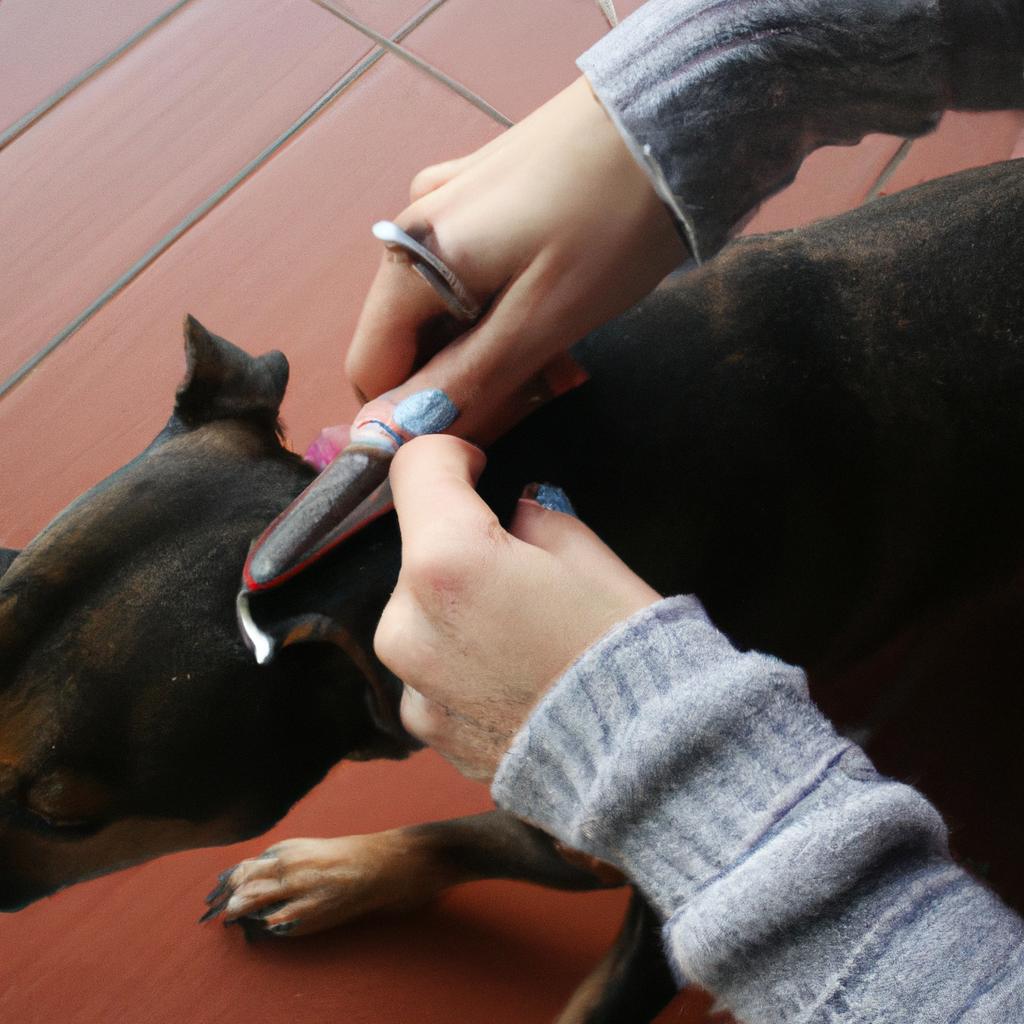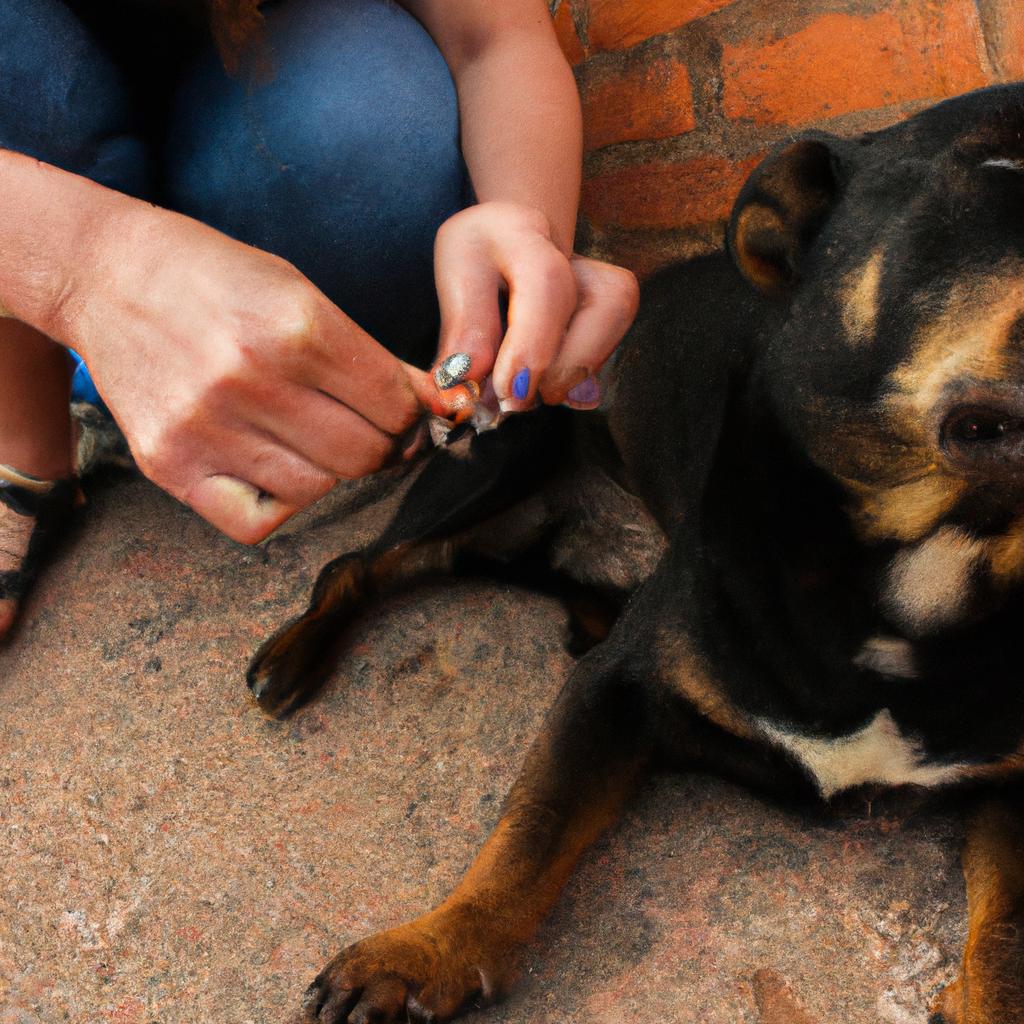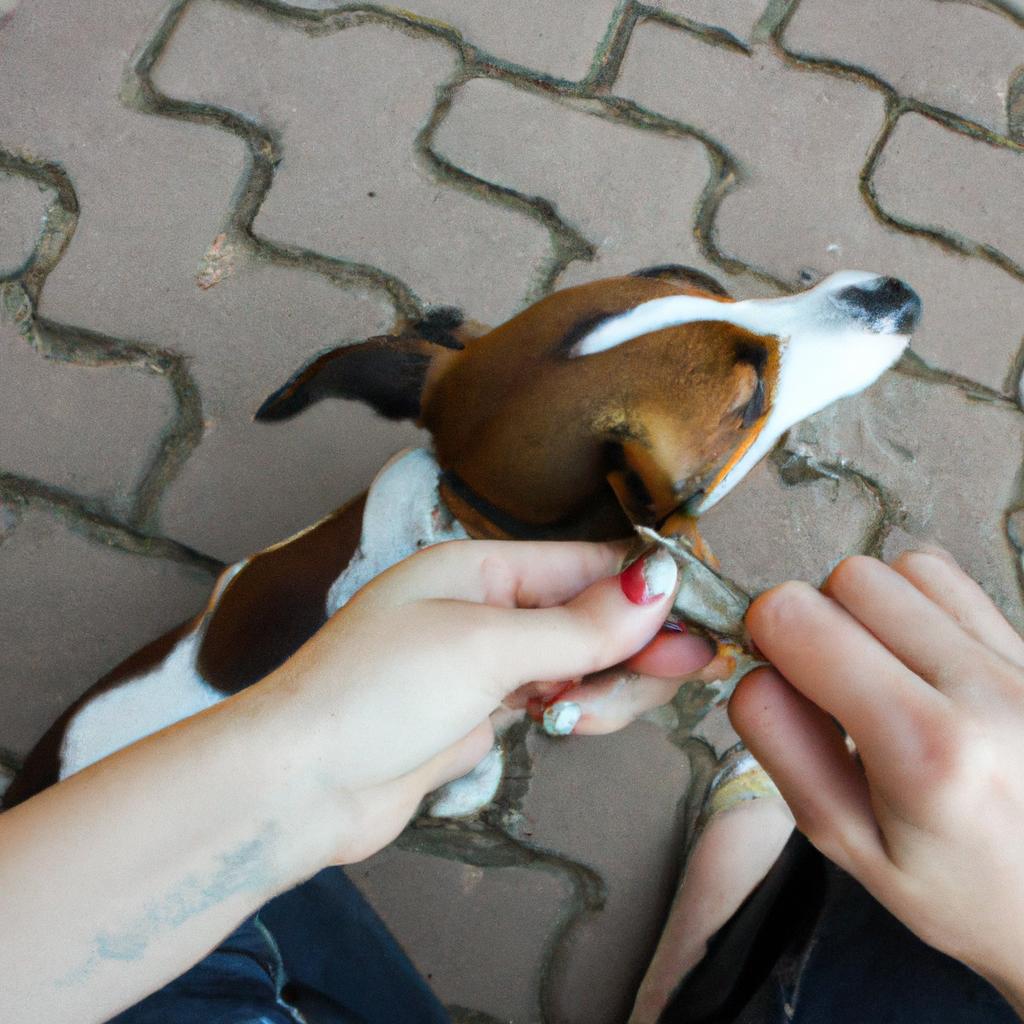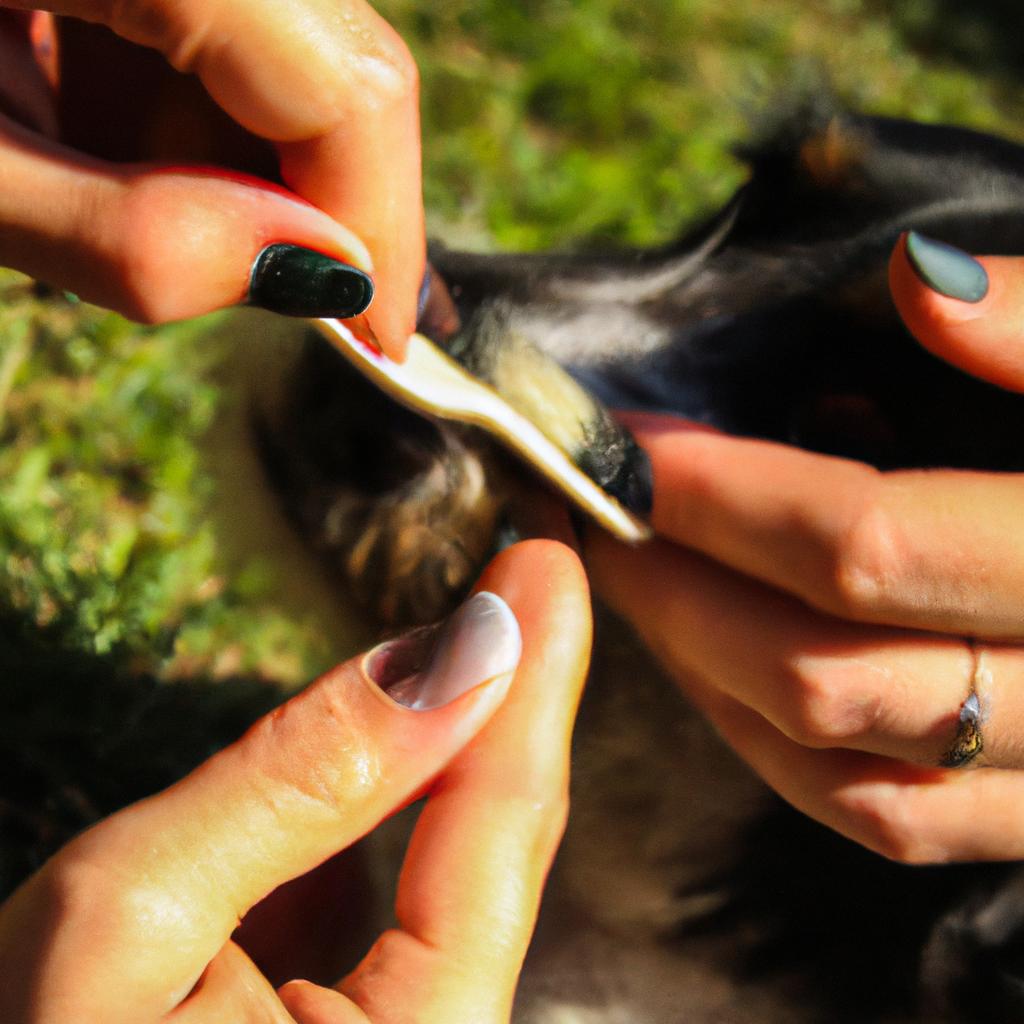Paw Pad Care in Dog Grooming Salon: Nail Trimming Tips

Paw pad care is a crucial aspect of dog grooming that often goes overlooked. Neglecting the proper maintenance and attention to a dog’s paw pads can lead to discomfort, pain, and potential infections. In this article, we will explore the importance of nail trimming in maintaining healthy paw pads within a dog grooming salon setting.
Consider the case of Max, a Labrador Retriever who frequented a local dog grooming salon. Despite being well-groomed in other areas, his paw pads were consistently neglected during each visit. Over time, Max began experiencing difficulty walking and showed signs of discomfort when pressure was applied to his paws. The underlying cause? His overgrown nails had started curling into his paw pads, leading to inflammation and ultimately hindering his mobility. This unfortunate situation highlights the significance of regular nail trimming as an essential part of overall paw pad care in any professional dog grooming salon.
Within this context, it becomes evident that understanding and implementing proper nail trimming techniques is paramount for groomers working with dogs on a daily basis. By following best practices for nail trimming in conjunction with comprehensive paw pad care routines, groomers can ensure their canine clients’ optimal comfort and health. Throughout this article, we will provide useful tips and guidelines aimed at promoting the well-being of a dog’s paw pads through effective nail trimming in a dog grooming salon setting.
-
Use the right tools: It is crucial to have the appropriate tools for nail trimming, such as quality nail clippers or grinders specifically designed for dogs. Avoid using human nail clippers as they may cause discomfort or injury to the dog.
-
Familiarize yourself with canine anatomy: Groomers should have a basic understanding of a dog’s paw structure and how it relates to nail trimming. This includes being able to identify the quick, which is the sensitive area within the nail that contains nerves and blood vessels.
-
Trim nails regularly: Regular nail trims are essential to prevent overgrowth and curling into the paw pads. The frequency varies depending on the dog’s breed, activity level, and environment, but generally, monthly trims are recommended.
-
Take precautionary measures: Before starting any grooming procedure, it is important to ensure the dog feels comfortable and secure. Gently handle their paws and reward them with treats or praise throughout the process to create positive associations.
-
Gradually introduce dogs to nail trimming: Some dogs may be apprehensive or fearful of having their nails trimmed initially. It is best to introduce them gradually by touching their paws frequently and providing positive reinforcement until they become accustomed to the sensation.
-
Be mindful of the quick: When trimming nails, groomers must be cautious not to cut into the quick as it can cause bleeding and pain for the dog. Trimming small amounts at a time while observing any signs of sensitivity can help avoid this issue.
-
Utilize alternative methods if necessary: For dogs with extremely long nails or those who are particularly sensitive, using a grinder instead of clippers can be an effective alternative. Grinders allow for more precise control and gradual shaping of the nails without risk of cutting into the quick.
-
Monitor for signs of injury or infection: After each nail trimming session, groomers should thoroughly examine the paw pads for any signs of injury, redness, swelling, or infection. If any abnormalities are detected, it is important to notify the dog’s owner and recommend appropriate veterinary care.
By following these guidelines and prioritizing regular nail trimming as part of a comprehensive paw pad care routine, dog groomers can play a crucial role in maintaining their canine clients’ overall comfort and well-being. Properly cared-for paw pads contribute to a dog’s mobility, health, and happiness, making it an essential aspect of professional grooming services.
Importance of Regular Paw Pad Maintenance
Imagine a scenario where a dog named Max is brought into a grooming salon with overgrown and untrimmed nails. Max’s owner, Sarah, notices that he has been slipping on the hardwood floors at home lately, causing him discomfort while walking. This situation highlights the importance of regular paw pad maintenance in dogs.
Regular care and attention to a dog’s paw pads are essential for several reasons. Firstly, keeping the nails trimmed helps maintain proper posture and reduces strain on their joints. Overgrown nails can alter the weight distribution on a dog’s paws, leading to gait abnormalities or even joint problems such as arthritis. Secondly, maintaining clean and healthy paw pads prevents infections and other foot-related issues. Excessive hair between the toes can trap dirt, debris, and bacteria, potentially resulting in painful mats or skin irritations.
- Proper nail trimming promotes better overall health and well-being.
- Regular cleaning of paw pads minimizes bacterial growth.
- Maintaining appropriate length prevents accidental scratching or injury.
- Preventing excessive hair growth eliminates discomfort during movement.
In addition to these points, understanding the anatomy of a dog’s paw pad is crucial. The table below provides an overview of its key components:
| Component | Description | Function |
|---|---|---|
| Digital Pads | Thick cushions located under each toe | Absorb shock while running or jumping |
| Metacarpal Pad | Located higher up along the front legs | Provides extra support when standing |
| Carpal Pad | Found above each wrist joint | Aids in balance |
| Dew Claw | Extra digit found higher up on some breeds’ paws | Helps with climbing or gripping objects |
Understanding these anatomical features allows groomers to provide targeted care and maintenance, ensuring dogs’ paw pads remain healthy and functional. By regularly attending to their paw pad needs, dog owners can help prevent discomfort, injuries, or potential long-term complications associated with neglected paws.
In the subsequent section, we will delve deeper into understanding the anatomy of a dog’s paw pad, providing valuable insights for effective grooming techniques and practices.
Understanding the Anatomy of a Dog’s Paw Pad
Having established the significance of regular paw pad maintenance, let us now delve into practical tips for nail trimming that will help maintain your dog’s overall paw health. To illustrate the importance of proper care, consider the case study below.
Case Study:
Imagine a scenario where a Labrador Retriever named Max regularly engages in outdoor activities such as running and playing fetch. Despite his active lifestyle, Max frequently experiences discomfort due to overgrown nails and cracked paw pads. This not only affects his mobility but also leads to an increased risk of infections. By following these nail trimming tips, you can prevent similar issues in your furry companion:
Nail Trimming Tips:
To ensure effective nail care while minimizing stress for both you and your pet, follow these recommendations:
-
Use appropriate tools: Invest in high-quality nail clippers or grinders specifically designed for dogs. These tools are available in different sizes to cater to various breeds and coat types.
-
Familiarize yourself with canine anatomy: Understand the structure of your dog’s nails before attempting any trimmings. Dogs have blood vessels called quicks inside their nails, so it is essential to avoid cutting too close to them to prevent bleeding and pain.
-
Gradually introduce nail trimming routine: Start by gently handling your dog’s paws from a young age, gradually building trust and making them comfortable with the process. Reward positive behavior during grooming sessions with treats or praise.
-
Trim nails at regular intervals: Aim to trim your dog’s nails every 2-4 weeks depending on their growth rate and activity level. Consistency is key to maintaining optimal paw pad health.
Taking care of your dog’s paw pads not only enhances their comfort but also promotes overall well-being. Consider the following benefits:
- Prevents painful conditions like split or cracked paw pads.
- Reduces the risk of nail-related injuries during physical activities.
- Minimizes discomfort caused by overgrown nails rubbing against surfaces.
- Promotes proper weight distribution, preventing joint strain.
Emotional Table:
| Benefit | Description |
|---|---|
| Prevention of Painful Conditions | Regular maintenance reduces the likelihood of split or cracked paw pads. |
| Enhanced Mobility and Comfort | Properly trimmed nails prevent discomfort when walking or engaging in physical activity. |
| Protection from Nail Injuries | Shortened nails minimize the risk of injury while running or playing. |
| Support for Joint Health | Maintaining optimal paw pad health contributes to proper weight distribution and reduces strain on joints. |
By implementing these nail trimming tips, you can ensure your dog’s paws remain healthy and comfortable. Next, we will explore how choosing the right tools for paw pad care is equally important in maintaining their overall well-being and mobility
Choosing the Right Tools for Paw Pad Care
Understanding the Anatomy of a Dog’s Paw Pad is crucial in providing proper care and maintenance. Let’s explore some tips for nail trimming to ensure the well-being of these sensitive areas.
Imagine this scenario: Max, a 4-year-old Labrador Retriever, visits his favorite dog grooming salon for his regular paw pad care session. The groomer begins by examining Max’s paws carefully, taking note of any abnormalities or signs of discomfort. This initial assessment allows the groomer to tailor their approach based on Max’s specific needs.
To start with, it is important to use appropriate tools when trimming a dog’s nails. Here are some guidelines:
- Choose high-quality nail clippers that suit your dog’s size and breed.
- Opt for guillotine-style clippers for small dogs, scissor-style clippers for medium-sized dogs, and plier-style clippers for larger breeds.
- Ensure the blades are sharp to avoid crushing the nails during trimming.
- Keep styptic powder or cornstarch nearby in case bleeding occurs from accidentally cutting into the quick.
Now let’s delve into some essential tips that can help make the process smoother and more comfortable for both you and your furry friend:
-
Gradual Approach:
- Introduce nail trimming gradually from an early age to help familiarize your dog with the process.
- Start by getting them used to having their paws touched, then progress to handling their feet while offering treats as positive reinforcement.
-
Proper Technique:
- Hold your dog’s paw firmly but gently, ensuring they feel secure throughout the process.
- Trim only small portions at a time; remember not to cut too close to the quick (the pink part inside the nail) as it may cause pain and bleeding.
-
Distraction Techniques:
- Use treats or toys as distractions during nail trims to keep your dog occupied and relaxed.
- Consider engaging in a favorite activity before the session to create a positive association with paw pad care.
Now equipped with an understanding of nail trimming tips, let’s move forward to explore a step-by-step guide on how to safely trim your dog’s nails.
Step-by-Step Guide to Safely Trimming Dog’s Nails
Paw Pad Care in Dog Grooming Salon: Nail Trimming Tips
Choosing the Right Tools for Paw Pad Care is crucial to providing a safe and comfortable grooming experience for dogs. One example of an essential tool is a high-quality pair of nail clippers designed specifically for dogs. These clippers have sharp blades that can cleanly cut through the dog’s nails without causing any discomfort or injury. Additionally, using a file or grinder after trimming can help smooth out rough edges and prevent snagging.
To ensure successful paw pad care during nail trimming sessions, consider the following tips:
-
Maintain a calm environment: Dogs are sensitive to their surroundings, so it’s important to create a peaceful atmosphere in your grooming salon. Play soothing music and minimize loud noises to keep the dog relaxed throughout the process.
-
Use positive reinforcement techniques: Rewarding good behavior with treats or praise can make the nail trimming experience more enjoyable for both you and the dog. This positive association helps build trust and reduces anxiety during future grooming sessions.
-
Take breaks if needed: Some dogs may become anxious or restless during extended periods of nail trimming. If necessary, take short breaks between each nail trim to give them a chance to relax before proceeding further.
-
Seek professional guidance when unsure: If you’re uncertain about how to properly trim a dog’s nails or encounter difficulties with certain breeds, don’t hesitate to seek advice from experienced professionals in the field who can provide valuable insights.
Incorporating these practices into your paw pad care routine will not only enhance the quality of your services but also contribute towards maintaining healthy paws for our furry friends.
| Pros | Cons |
|---|---|
| Reduces risk of injuries | Requires practice |
| Promotes overall health | May cause slight discomfort |
| Enhances comfort | Time-consuming |
| Builds trust with dogs | Requires regular maintenance |
It is essential to be proactive in maintaining the well-being of a dog’s paws, especially after nail trimming sessions.
Preventing and Treating Paw Pad Injuries involves implementing proper cleaning techniques, recognizing signs of injury or infection, and providing appropriate treatment when necessary. By following these guidelines, you can ensure that your furry clients’ paws remain healthy and happy.
Preventing and Treating Paw Pad Injuries
Transitioning smoothly from the previous section, let us now delve into the importance of maintaining healthy paw pads for our furry friends. Imagine a scenario where a dog named Max eagerly greets his owner at the door after a long walk. However, upon closer inspection, Max’s paw pads are cracked and dry, causing him discomfort and potential pain. As responsible pet owners, it is crucial to understand how to prevent such issues from occurring.
To ensure optimal paw pad health, here are some essential tips:
-
Regular Inspection:
- Examine your dog’s paws regularly for any signs of injury or damage.
- Look out for cuts, abrasions, cracks, or foreign objects stuck between their toes.
- Early detection allows prompt intervention and prevents further complications.
-
Moisturizing Routine:
- Implement a moisturizing routine using pet-friendly balms or creams specially formulated for paw pads.
- Apply these products after walks or prolonged periods on rough terrain to keep the paw pads hydrated and supple.
-
Protect Against Harsh Weather Conditions:
- Extreme temperatures can take a toll on dogs’ paw pads.
- During hot summer months or icy winters, consider protective boots designed to shield their paws from scorching surfaces or freezing ice/snow.
-
Provide Proper Nutrition:
- A balanced diet plays a significant role in maintaining overall canine health.
- Ensure that your dog receives appropriate nutrients necessary for strong immune function and skin integrity.
Emphasizing the significance of these practices, we can envision a happier Max with well-nourished and pampered paw pads. Moving forward into the subsequent section about “Tips for Soothing and Moisturizing Dog’s Paw Pads,” we will explore additional methods to provide relief and nourishment, ensuring our furry companions experience optimal paw pad health.
Tips for Soothing and Moisturizing Dog’s Paw Pads
Transition from previous section H2:
Understanding the importance of preventing and treating paw pad injuries is crucial for maintaining optimal paw health in dogs. By taking proactive measures, dog owners can ensure their furry companions have healthy and happy paws throughout their lives. In this section, we will explore essential tips for soothing and moisturizing a dog’s paw pads to promote overall well-being.
Section: Tips for Soothing and Moisturizing Dog’s Paw Pads
To illustrate the benefits of proper paw pad care, let us consider an example involving a 5-year-old Labrador Retriever named Max. Max frequently enjoys long walks on various terrains with his owner. However, due to exposure to rough surfaces, his paw pads became dry and cracked over time. To alleviate his discomfort and prevent further damage, his owner implemented the following practices:
- Regular moisturization: Applying a high-quality pet-safe paw balm or lotion regularly helped keep Max’s paw pads hydrated and protected against environmental stressors.
- Foot soaks: Soaking Max’s paws in warm water infused with natural ingredients such as chamomile or oatmeal provided relief from irritation while promoting healing.
- Avoiding harsh chemicals: Using gentle cleaning products during grooming sessions ensured that no harsh chemicals were left behind on Max’s paws, reducing the risk of allergic reactions or skin irritations.
- Proper trimming: Consistently maintaining well-trimmed nails prevented them from exerting excessive pressure on Max’s paw pads, minimizing discomfort caused by misalignment.
The emotional well-being of our canine friends should not be overlooked when it comes to caring for their precious paws. Consider these heartwarming testimonials from satisfied dog owners who followed similar strategies to soothe and moisturize their pets’ paw pads:
| Testimonials |
|---|
| “Since I started using a specialized balm on my dog Bella’s paw pads, she no longer hesitates to go on walks – her joy is palpable!” |
| “After incorporating foot soaks into my dog Cooper’s grooming routine, his once irritated and cracked paw pads have become smooth and healthy. Seeing him content makes my heart soar.” |
| “By using gentle cleaning products during grooming sessions, I noticed a significant improvement in my dog Riley’s overall comfort. It brings me peace of mind knowing their paws are well taken care of.” |
| “Trimming Coco’s nails regularly has made such a difference! She now prances around without any signs of discomfort, reminding me why I love being a pet owner.” |
In conclusion, prioritizing the soothing and moisturization of your dog’s paw pads can significantly enhance their quality of life. By implementing simple yet effective techniques like regular moisturization, foot soaks, avoiding harsh chemicals, and proper nail trimming, you can ensure that your furry friend enjoys optimal paw health for years to come. Your efforts will not only alleviate any discomfort they may be experiencing but also contribute to their overall happiness and well-being.





